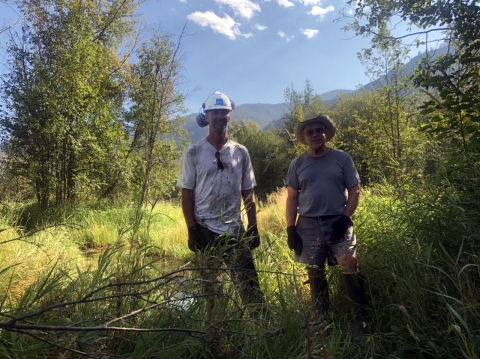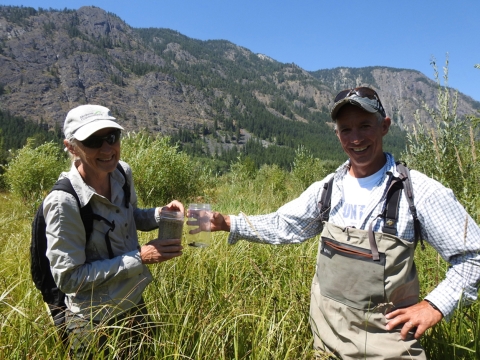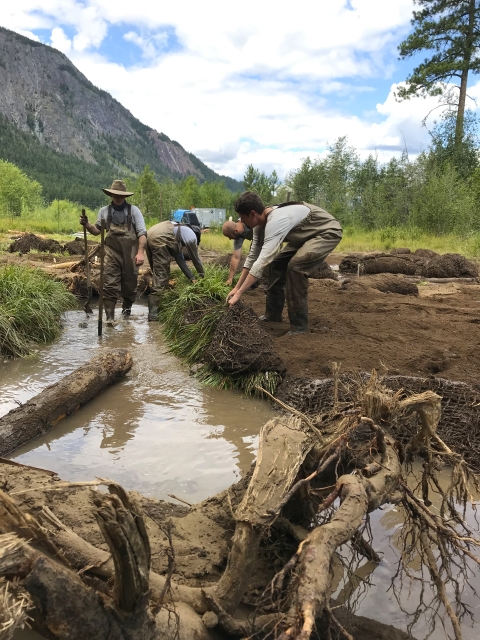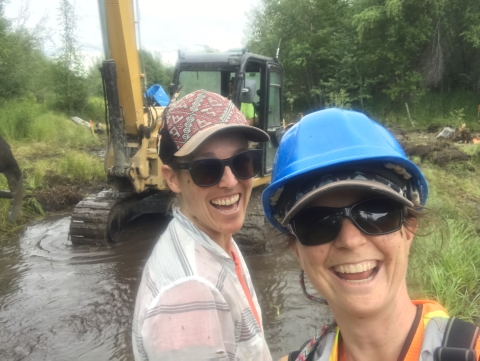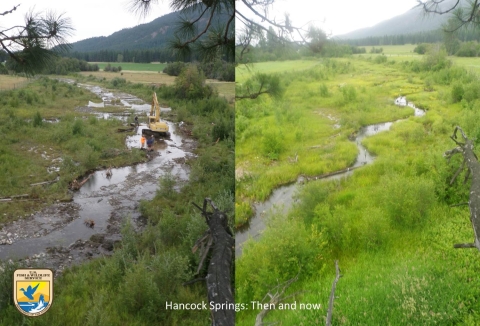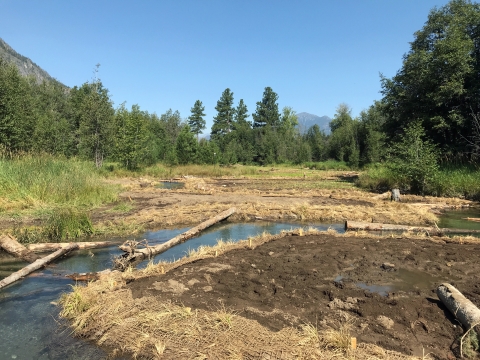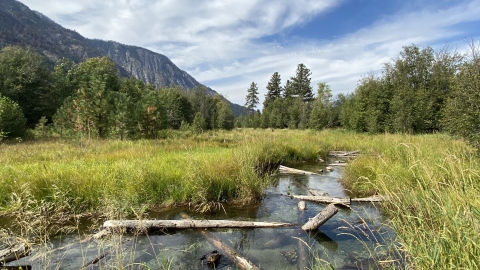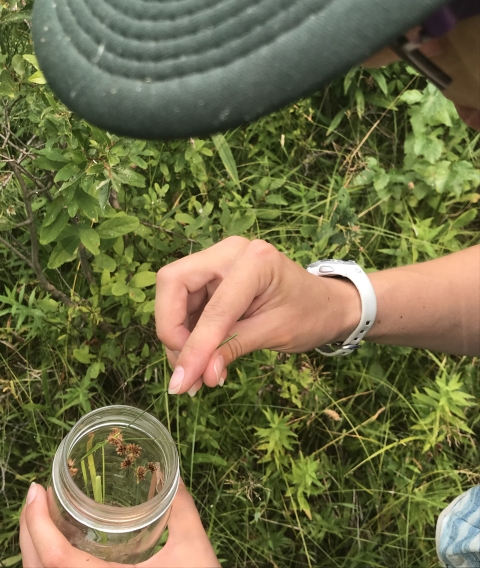I’m a volunteer. Nearly everyone I know is. Some volunteer for the occasional event or program. Others volunteer a substantial amount of their time to one cause or another. But what motivates a person to volunteer for conservation?
To maintain healthy species populations and ecosystems, fish and wildlife need the freedom to move and migrate. As habitats and migration routes are affected by climate change and fragmented by roads, fences, energy development and other man-made barriers, wildlife struggle to reach necessary areas to feed, breed and find shelter. A wildlife corridor is a piece of undeveloped land connecting two habitats so wildlife can move safely between them.
Learn more about wildlife corridor across the Methow Valley.
I was talking with a colleague recently about a long-term project he’s been involved with in the Methow Valley. Robes Parrish has spent years restoring habitat at Hancock Springs, a special place with a history of homesteading, dairy farming, and now of restoration for wildlife. He’s worked on every aspect of the project, from planning and coordinating with partners and engineering solutions to on-site, hands-on, muddy fieldwork. But no matter how difficult the fieldwork, volunteers have always pitched in.
Robes mentioned some names, and I decided to call them up and find out what motivates them to help on a conservation project like the one at Hancock Springs. The first person I talked to was Scott Stluka. Scott, like many people over the past decade, moved to the Methow Valley fairly recently. He started out as a graduate of Western Washington University in marine biology and worked in fisheries for Grant Public Utility District at Priest Rapids and Wanapum dams. Later on, he worked for Weyerhauser, eventually running a research lab. When his wife retired from teaching in 2017, they moved to Twisp.
Scott was “chomping at the bit to volunteer,” finding many great opportunities, eager to learn about his new home area. He helped a PhD student from the University of Washington’s Prugh Lab collect bobcat and coyote scat during the winter for a study on predator interaction, went on butterfly and plant walks, hung out with birders and mushroomers, joined geology hikes. He builds and maintains bird boxes, putting them up with Washington Department of Fish and Wildlife oversight and doing nest surveys with the Audubon Society. He’s pulled miles of old abandoned barbed wire that entangles wildlife (“I call it the devil’s rope,” he said).
And he collected sedge seeds for the habitat restoration project at Hancock Springs. Each volunteer was given a different species to look for. After several hours, Scott said, his contribution was less than two tablespoons of seeds! All these seeds were sent away to Idaho to be implanted in fiber mats and grown for later use.
When “later on” arrived, Scott joined the crew for Phase II of the project. Phase I restored a section of stream close to the old dairy barn. Phase II tackled the next section downstream. The process involved digging a new, winding channel using an excavator, then rebuilding the stream, laying out the now-heavily-vegetated mats to reform new banks. When Scott returned to see whether this process had worked, “dramatic changes were visible.”
In the process of volunteering, Scott said, “You meet all kinds of people. The side benefits are amazing.” He spent a day picking seeds with Tuck Stebbins, a retired NASA astrophysicist, and “got a great lecture on gravitational waves.” Tuck also moved to the Methow about five years ago. He describes the area as having “a very vigorous community with a strong sense of self-identity.” He lives close to Hancock Springs and is “interested in watching the beavers sabotage the whole project,” he laughed. He joins Scott in tearing out old barbed wire, too.
“Working with people like Kristen Kirkby and Robes, I get to learn by observing the professionals,” Tuck said. Kristen works for Cascade Fisheries. She leads pre- and post-project inventories, recruiting volunteers to collect data on stream health and diversity.
Kristen has been in the Methow since 2013, relocating from Cordova, Alaska. She grew up on the West side of the Cascade Mountains and attended Whitman College, earning a degree in biology and environmental science. Her Master’s degree in Fisheries Science came from Oregon State University. She has led a variety of monitoring programs, measuring the success of restoration projects.
Hancock Springs, she said, is unique in the Methow Valley, calling it “superproductive.” Three species listed through the Endangered Species Act are found in its waters: steelhead, Chinook, and coho. She has made repeat visits to collect data demonstrating the health of the springs, bringing along volunteers to capture and identify macroinvertebrates and check water quality.
“We do this with kids for education,” she pointed out; but it’s just as exciting and informative for adults. She is working on expanding outreach to adults through volunteering. For example, she brought some college students from Whitman on a monitoring effort that involved snorkeling in the river. “They were so excited!” she said.
Her own experience volunteering on a salmon spawning ground survey project on the Umatilla Indian Reservation is what drew her into fisheries work. Now on the board of Methow Conservancy, she supports their efforts to involve the community in hands-on science projects. “It is amazing how many people show up and get involved,” she said. “It seems like once people start, it sticks,” and they keep coming back. That’s a good thing for monitoring projects especially, since those involve multiple visits to project sites.
Tuck is one of the volunteers Kristen refers to as “the stalwarts.” By now, he has worked on dozens of conservation projects in the area, but Hancock Springs remains fascinating. “This little patch of ground endlessly surprises me. I don’t know if Robes knew all along this would work, but words cannot express what a remarkable success this appears to be. The proof of the pudding’s in the fish,” he said, recounting how he saw spawning salmon in the restored stream while helping to plant hundreds of trees and shrubs in 2021.
Restoration often looks more like construction than anything else. Heavy equipment rolls in on supportive matting to keep it from miring in the wetland, then tears up ground and shoots it back into newly assigned places. It is used to rip a stream channel right down to the gravelly morainal base, and to lift logs and drop them in a carefully careless-looking fashion imitating nature. But within a few months of all this activity, the stream at Hancock Springs was sinuous and clear, gloriously overgrown in healthy plants whose seeds had been meticulously collected by volunteers years before.
“The level of destruction that they wrought and then un-did is remarkable.” But this, stated Tuck, “is a methodology for restoration that works.”
Volunteer Phil Davis agrees. Hancock Springs “is one of the coolest projects I’ve been a part of,” he said. He got to see Phase I via a “slushy tour,” describing the team tackling the project as “on a mission.” His motivation in joining the effort was to see the progress being made. That, he said, was “rewarded in a huge way,” by seeing a Chinook salmon sitting on a redd in the stream in 2021.
“It’s inspiring to be around people who are so energized by a project.” He described Robes as “oozing inspiration and energy; it sucks you in that much more.”
Phil has tapped into what he called “the receiving end of the incredible community spirit” of the Methow Valley. As one of the founders of Homestream Park, he has seen hundreds of hours of volunteer labor invested there. The park is located just below the bridge that crosses the Methow River at the entrance to the main downtown of Winthrop. The park is dedicated to the indigenous people and the salmon of the area. “Having volunteers support your own vision is amazing,” he said.
His first introduction to the area was in 1986. “We had a colicky first kid,” he said, and he and his wife were having a hard time. His mother-in-law took over childcare for a weekend and sent them to Sun Mountain Lodge. They were struck by the beauty of the place. In 1993, they bought some property for recreation, bringing their family over from Seattle on weekends and vacations.
When Phil retired from business in 2005, he became the executive director of the Hoh River Trust for five years. After stepping down from that position, he and his wife began splitting their time between Seattle and Winthrop. When I asked him where his home was, he replied, “My heart home? Or my voting address?”
But retirement has not meant taking it easy. Phil’s plan for the next twenty years is to investigate “how we as a community can learn from the original human relationship to place, and to salmon in particular, to re-establish an abundance of naturally spawning salmon in the Methow.”
Working closely with tribal people is another transformative experience. He cites Randy Lewis and Mark Miller as influential tribal members who have helped to shape his thinking about equity and community. Conversations with them led to a new concept of conservation he calls “the spirit easement.” Spirit easements acknowledge that the spirits of tribal ancestors live among us on the land, and grant their right to remain. The spirits themselves are listed as the beneficiaries on the legal easement document. This is “how we honor the original inhabitants of this land.”
Phil was part of an effort to return land up the Chewuch River to the Colville Confederated Tribes. And he works on housing equity for all residents of the Methow, too, as president of a housing trust. The Methow, he said, is a “special place.” The housing trust aims to “ensure privilege is not a prerequisite to feeling like you belong here.”
Retirees are not the only ones to volunteer at Hancock Springs. Tiffany Ban moved to the Methow in 2020 during the pandemic, working remotely for her job in Seattle but living rurally. Within the first month or so of her arrival, she was out wading at Hancock Springs with other volunteers, counting macroinvertebrate species and testing water quality. “It’s right up my alley,” she said, since she holds a Master’s degree from the University of Washington in hydrology and worked for Seattle Public Utilities monitoring dams.
But it wasn’t the only volunteer project she chose. She also re-seeded bulldozer tracks left behind from fighting the Cedar Creek fire and repaired mountain bike trails damaged by dozers, learned to identify invasive plants and pull them alongside trails, helped with maintenance of Homestream Park, and joined cleanups of stretches of the highway adopted by the Methow Conservancy. She sees volunteering as a way to integrate into the community and learn the history of the Methow.
Tiffany didn’t grow up with volunteering as a model. But as an adult seeking meaning in her life, something not always provided by her paid work, she finds volunteering gives her a sense of purpose. And when her workplace insisted she quit teleworking and return to the office, she quit and found part-time employment at a physical therapy clinic. Working part-time allows her to continue volunteering and meeting people with similar interests. She especially likes volunteering through Methow Conservancy because “I know how important these kinds of projects are. It’s important to manage natural resources both for people and the ecosystems already in place here. It’s a delicate balance,” and good for agriculture, wildlife, and recreation all at the same time.
Growing up in Hawai’i, Tiffany said, she was very much aware of the separation between locals like her family and newcomers who idealize living there. She noted there was not much interaction between these two functionally separate communities. “I know how it must look to locals” in the Methow, she said, to have people like herself moving into the area, and worries she is connecting more with other newcomers than with long-time residents. “How do we ease the transition that’s happening in the Methow?” she wondered, thinking of the recent influx of people fleeing urban environments. But, she said, her job helps her interact with people she might not meet otherwise. And the volunteer projects she’s joined give her a unique connection to the place. “I look forward to seeing the results of re-seeding,” she said.
If a community is motivated, Phil said, it can be “inspiring and rewarding. We can set an ethos in a spirit of togetherness.” To me, this brings to mind Aldo Leopold’s land ethic. Aldo wrote, “We can only be ethical in relation to something we can see, understand, feel, love, or otherwise have faith in. When we see land as a community to which we belong, we may begin to use it with love and respect.” He believed acting to conserve heathy ecosystems and taking the focus off ourselves was a righteous path.
Perhaps that’s what these volunteers may have in common. Each acted to benefit the natural world right where they are. Each found wonder and satisfaction in seeing the transformation of a place from damaged to healthy and thriving. What better magic is there than seeing the restoration of nature?
Someone needs to reach out to find volunteers for projects like Hancock Springs. The entity that has done the bulk of the asking is Methow Conservancy. I spoke with Daniel Senner, the Conservancy’s Community Conservation Coordinator since 2017. Daniel earned a degree in biology at Western Washington University and worked with Cascade Fisheries. Then he spent a year with a land trust in Bellingham, where he “learned how to manage a volunteer army.”
With the Methow Conservancy, he finds working with volunteers “one of the funnest parts of my job.” He especially enjoys taking people to places they wouldn’t ordinarily go and putting them together with professional experts. Once they’re out there, he says, they have “so many questions and observations. I love how it bridge those gaps in experiences. And it’s an opportunity for word to get out to the public” about conservation projects.
The first big volunteer mobilization led by Methow Conservancy was after the Carlton Complex Fire in 2014. More than a hundred people took part in “seed mobs,” spreading native seeds onto bulldozer tracks made for fighting fire. The dozer tracks ran along power lines, across both private and public land. Seed mobs continue: after the Cedar Creek Fire of 2021, reseeding took place at Sun Mountain. Seed for these kinds of projects often come from Rob Crandall, owner of Methow Natives. Rob is proud to have been involved in habitat restoration projects since 1999.
Once people volunteer, many return for more projects. Daniel estimates they have seventy-five to a hundred volunteers involved with the Conservancy. “We have some regulars,” he said,” but at each event, I see new faces.” The Conservancy is the long-term steward of Homestream Park, where a lot of volunteer help has been focused.
Daniel agrees that there is a very strong conservation community in the Methow. Why? He speculated that it could be because there is an abundance of public lands and a healthy population of wildlife. Add to that having “great organizations that help tell the story of conservation,” who have helped create an appealing conservation ethic. And, he said, “at the end [of a project], you’ve done something really tangible, and that’s very satisfying.” Aldo Leopold would approve.
I think of Tuck, Phil, and Scott all expressing amazement at seeing Chinook salmon promptly back in the stream at Hancock Springs, of Tiffany anticipating an eruption of native grasses in the old dozer tracks. There is real satisfaction in taking action to heal a damaged place. The same satisfaction is felt by the professionals who make a living in restoration, like Kristen, Daniel, and Robes. As Tiffany said, “I want to make sure these projects have a lasting impact, and to do something good for the land and the people.”


